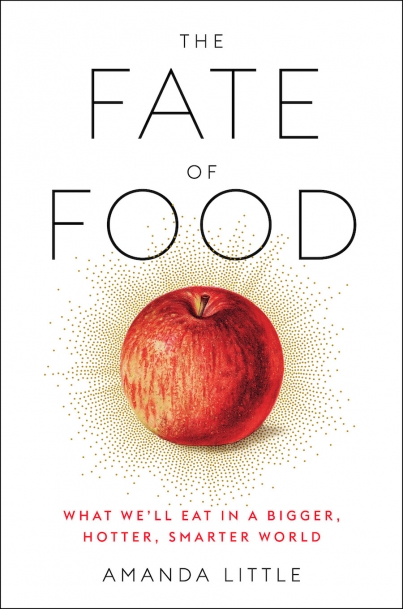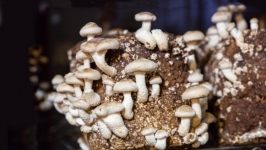The Fate of Food
Crisp, juicy apples engineered to withstand volatile swings in temperature. Peppery arugula and butter-soft lettuces growing without soil at a hyper-controlled indoor vertical farm. A slice of tender chicken breast cultured from animal tissue in a lab. Crystal pure drinking water that had been human waste an hour prior. 3-D “printed” meals custom-designed to meet an individual’s nutritional needs. Will this be our sustenance 50 years from now?
These foods are available right here, right now, in the United States. Amanda Little has tasted all of the above, and more, in the three years she spent traveling to 11 countries and 13 states, driven by one critical question: What will we eat on a planet transformed by climate change and population growth?
We’re living in a world of extremes—drought, heat, floods. In response, innovators and disrupters around the globe are creating climate-resilient food systems. Little, a professor of journalism and science writing at Vanderbilt University, introduces us to an array of farmers, scientists, engineers, professors, and activists. She brings these pioneers to life, deftly weaving in their back stories and discovering what informed their current pursuit. Ironically—or not—most grew up with some connection to farming. That love for the environment continues to fuel their impassioned dedication to save the planet and find ways to feed the world.
Little meets with a third-generation apple grower in Wisconsin on the morning a spring frost has devastated his 350-acre orchard. “If these [climate] extremes were the new normal, he and his fellow growers needed a new plan to keep apples in this region alive.” In Kenya, she witnesses the apparent miracles that GMO maize has brought to many parts of the impoverished country. “To me, GMOs represented the worst aspects of industrialized agriculture in the U.S., but I also wondered whether, in an era of climate volatility and rapid population growth, bioengineered seeds could benefit rural African farms and the people who tend them. It seemed that rising pressures might justify the adoption of controversial tools.”
In a cotton field in Arkansas, she watches a robot equipped with digital cameras differentiate weeds from cotton seedlings, eradicating the invaders with pinpoint blasts of herbicide. Within a massive indoor organic farm in China, sensors monitor the soil and manipulate irrigation and fertilizer accordingly. China is the world’s biggest food producer despite explosive population growth, limited arable land, severe freshwater shortages, and polluted soils. Highly controlled indoor farms may provide a viable solution.
Closer to home, Little visits a vertical farm in Newark, New Jersey, “an industrial cathedral teeming with plants and processing power, a futuristic habitat designed to change the way we grow produce.” Across the Atlantic, 4,000 tons of salmon swim in pens floating in Norway’s icy waters. Certified by the Aquaculture Stewardship Council, about a third will be sold to Whole Foods and Walmart. Norway boasts the world’s largest farmed salmon fishery, and the CEO whom Little meets envisions a Blue Revolution in which aquaculture will replace wild-caught fish and provide sustainable protein to billions of people. But how to deal with the excrement that befouls the oceans and chokes marine ecosystems?
Back in Berkeley labs, cultured meats are grown from tiny samples of animal muscle fat and connective tissues. Still in the R&D phase, these cell-based meats are not to be confused with plant-based meat alternatives such as Beyond Meat and the Impossible Burger which have already become mainstream. Industrial giants Tyson and Cargill have poured money into these innovations, a sure sign of their potential.
Israel has become a global leader in water technology. Many parched countries – including the United States – now seek this desert nation’s expertise on ‘smart water networks’ like desalination plants; digital technology that locates and prevents potentially catastrophic pipeline leaks; and recycled wastewater treatment facilities. “Recycled wastewater is the fastest-growing area in the water industry,” Little notes, “because [while] not every city has an ocean, lakes and rivers, everybody’s got sewage.”
The Fate of Food wrestles with the Big Questions. Throughout the book, Little grapples with her own confounded opinions and challenges her assumptions. “I had to shed my old hang-ups and misconceptions about food and explore new ideas and future possibilities.”
“Drudgery and hunger provide a motive for developing tools,” says Columbia University professor Ruth DeFries, one of Little’s erudite resources. “Every new agricultural tool introduced since the first farming settlements has been designed with the same goal: to coax more food from the earth with less human effort. Each ag technology has been one more link in the lengthy chain of experiments aimed at producing a bigger, more reliable food supply with less work.”
However, the book’s premise is that many have a deep distrust of technology as applied to food. Little explains the rift. “A generation of entrepreneurs, aided by technology, is vying to build a better, ‘smarter,’ more resilient food system and create new ways to harness the sustenance it yields.” And on the flip side, “Most sustainable food advocates bristle at the idea of reinventing food. They advocate for a return to preindustrial, organic, and biodynamic farming practices. One side covets the past, the other the future.”
So which approach will provide enough food to feed nine billion people?
Little proposes ‘third way thinking’ that merges tradition with technology. “Our challenge is to borrow from the wisdom of the ages and from our most advanced technologies to forge a kind of “third way” to food production. Such an approach would allow us to improve harvests while restoring, rather than degrading, the underlying web of life.” In other words, embrace the vast power of the digital age to help us produce food more effectively, conserve energy, reduce waste, and use water more efficiently.
The Fate of Food is as impactful and urgent as Michael Pollan’s The Omnivore’s Dilemma. Read this book with pen in hand and digest it slowly. The world is being transformed by climate and computers, and Amanda Little’s tome reminds us to keep our minds—and palates— open to creative solutions. Because we no longer have the luxury of the status quo.
Amanda Little | @amandalittletrip
Beyond Meat | @beyondmeat
Impossible Burger | @impossible_foods
The Fate of Food
Michael Pollan | @michael.pollan
The Omnivore’s Dilemma







